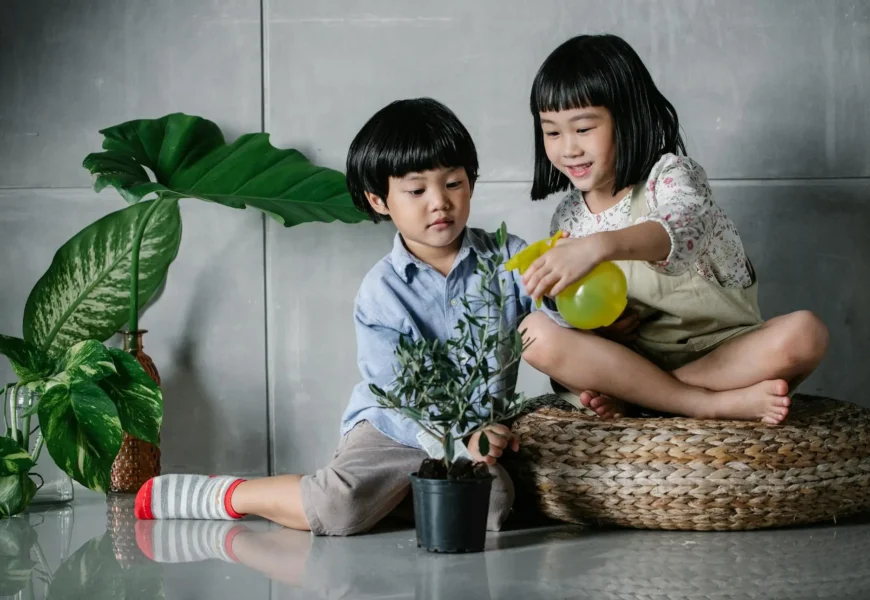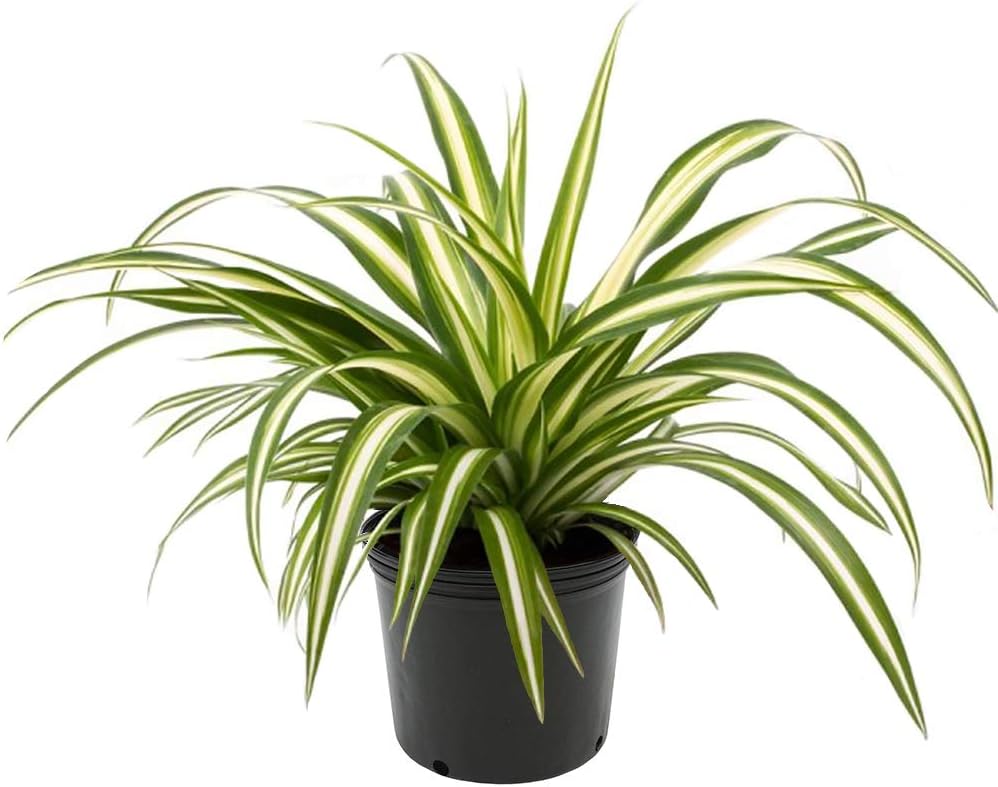Welcome to the enchanting world of indoor gardening! As a passionate plant lover and supporter of eco-friendly practices, I am excited to offer you some helpful tips on incorporating easy plants into your family’s daily routine, particularly if you have children.
Table of Content:
Introduction
In my recent blog post Top 10 Houseplant Trends to Spruce Up Your Home in 2024, I delved into the exciting world of indoor gardening, exploring the latest trends and innovations that can transform any space into a lush oasis.
Today, however, our focus shifts slightly to accommodate the unique needs and challenges of households with young children. We’ll explore the wonderful benefits of having kid-friendly houseplants, discover some of the easiest varieties to care for, and even delve into fun activities that you and your little ones can enjoy together.
Benefits of Houseplants for Families
Before we dive into the specifics, let’s take a moment to appreciate the myriad benefits that houseplants bring to our homes, especially when children are involved. As discussed in my article Breathe Easy: Beautify Your Living Room with Top Plants for a Healthy, Happy Home, indoor plants offer more than just aesthetic appeal. They play a crucial role in improving air quality by absorbing carbon dioxide and releasing oxygen, creating a healthier environment for the whole family.
Furthermore, numerous studies, including those highlighted in Nature’s Happy Place: Science Says Houseplants Boost Your Mood & Focus, have shown that surrounding ourselves with greenery can have a profound impact on our mental well-being. From reducing stress and anxiety to increasing productivity and creativity, the presence of houseplants can transform our homes into havens of tranquility and inspiration.
The Challenge of Houseplants with Kids
However, as any parent or caregiver knows, maintaining a thriving indoor garden can be a daunting task, especially when energetic little hands are constantly exploring their surroundings. In my article How to Deter Pets from Chewing on Houseplants: Effective Tips, I discussed strategies for protecting our green companions from curious pets. Similarly, when it comes to children, ensuring the safety of both the little ones and the plants themselves becomes paramount.
Fear not, for I am here to guide you through this delightful journey of combining houseplants with parenthood. By selecting the right varieties and implementing some simple strategies, you can enjoy all the benefits of indoor gardening while creating a safe and stimulating environment for your children to thrive.
Top Kid-Friendly Houseplants
Now that we’ve established the incredible benefits of introducing houseplants into your family environment, let’s delve into some specific varieties that are perfect for households with children. These plants are not only easy to care for but also non-toxic, ensuring peace of mind for parents and caregivers alike.
A. Snake Plant (Mother-in-Law’s Tongue)
- Description: The Snake Plant, also known as Mother-in-Law’s Tongue, is characterized by its tall, spiky leaves that grow upright from the soil. With its striking appearance, it adds a touch of elegance to any space.
- Ease of Care: This resilient plant thrives on neglect, making it ideal for busy households. It requires infrequent watering and can tolerate low light conditions, making it a versatile choice for various rooms in your home.
- Non-Toxic Nature: One of the biggest advantages of the Snake Plant is its non-toxicity. Even if your little one decides to give it a taste, rest assured that it won’t cause harm. For more tips on choosing pet and child-friendly plants, check out my article on Best Non-Toxic Houseplants for Dog and Cat Owners in 2024.
B. Spider Plant
Liven Up Your Space with the Easy-Care Spider Plant!
This beauty features cascading "spiderettes" and thrives in indirect sunlight.
Perfect for home or garden décor, it also purifies the air and is safe for pets!
- Description: The Spider Plant is renowned for its arching leaves, adorned with tiny “baby spiderettes” that dangle from the parent plant like miniature spiders on a web. Its unique appearance adds a playful element to any room.
- Ease of Care: Like the Snake Plant, the Spider Plant is incredibly low-maintenance. It thrives in various lighting conditions, from bright indirect light to partial shade, and is easy to propagate, allowing you to expand your indoor garden effortlessly.
- Non-Toxic Nature: As with all the plants on our list, the Spider Plant is non-toxic, making it safe for children and pets alike. For more information on creating a safe environment for both your plants and furry friends, take a look at my guide on Pet-Friendly Houseplants: Creating a Safe Haven for Your Pet.
C. Ponytail Palm
- Description: The Ponytail Palm is a charming plant characterized by its unique bottle-shaped trunk and long, slender leaves that cascade gracefully from the top. Despite its name, it’s not actually a palm but rather a member of the agave family.
- Ease of Care: This resilient plant is perfect for beginners and busy parents alike. It stores water in its swollen trunk, allowing it to withstand periods of drought with ease. It thrives in bright, indirect light but can also tolerate lower light conditions.
- Non-Toxic Nature: Rest assured that the Ponytail Palm is non-toxic, making it a safe addition to homes with children and pets. To learn more about creating a harmonious environment for both your plants and animal companions, check out my comprehensive guide on Peace in the Plant Paradise: Solutions for Pet-Friendly Houseplants.
By incorporating these kid-friendly houseplants into your home, you can create a vibrant and nurturing environment where both your plants and your children can thrive. In the next section, we’ll explore some fun activities that you and your little ones can enjoy together, further enhancing the bond between your family and nature.
Fun Activities with Kids & Houseplants
Now that we’ve selected the perfect kid-friendly houseplants for your home, it’s time to get the whole family involved in the wonderful world of indoor gardening! Engaging children in plant care not only teaches them valuable lessons about responsibility and nature but also fosters a deeper connection with their environment. Here are some fun and age-appropriate activities that you and your little ones can enjoy together:
1. Decorating Pots
- Materials Needed: Plain terracotta pots, acrylic paint, paintbrushes, and any other decorative elements you desire (e.g., stickers, glitter, or markers).
- Instructions: Set up a designated area where you and your children can unleash your creativity. Encourage them to paint and decorate their own pots using vibrant colors and imaginative designs. Once the pots are dry, transplant your chosen houseplants into their newly adorned homes. This activity not only adds a personal touch to your indoor garden but also promotes artistic expression and fine motor skills.
2. Helping with Watering (Supervised)
- Materials Needed: A small watering can or spray bottle filled with water.
- Instructions: Involve your children in the watering routine by allowing them to help you water the plants under your supervision. Teach them the importance of watering plants in moderation and demonstrate how to check the soil moisture before watering. This hands-on experience not only instills a sense of responsibility but also provides an opportunity to teach basic plant care principles.
3. Observing Plant Growth
- Materials Needed: A notebook or journal and a magnifying glass (optional).
- Instructions: Encourage your children to observe the growth and development of your houseplants over time. Have them document their observations in a journal, noting any changes in leaf growth, flower development, or overall health. Use a magnifying glass to examine the intricate details of the plants up close, fostering an appreciation for the beauty and complexity of nature.
4. Educational Benefits
- Plant Science: Engage your children in discussions about plant biology, including topics such as photosynthesis, plant anatomy, and the importance of sunlight and water for growth.
- Responsibility: Emphasize the importance of caring for living things and the role that each family member plays in maintaining a healthy indoor garden.
- Environmental Awareness: Use this opportunity to teach your children about the importance of plants in our ecosystem and the benefits of indoor gardening for air quality and well-being.
By incorporating these fun and educational activities into your family routine, you can foster a love of nature and instill valuable life lessons in your children. For more inspiration on creating a green and inviting home environment, be sure to check out my article on Houseplant Parenthood Made Easy: 10 Tips for Beginners to Thrive.
Tips for Keeping Houseplants Safe with Kids
While incorporating houseplants into your family life can be a rewarding experience, it’s essential to take proactive measures to ensure the safety of both your children and your green companions. By implementing the following tips, you can create a harmonious environment where plants and kids can coexist safely:
A. Placement
- Out of Reach: Place houseplants out of the reach of curious hands by placing them on high shelves, countertops, or hanging baskets. This prevents children from accidentally pulling on leaves or knocking over pots.
- Secure Containers: Opt for sturdy, heavy pots or containers that are less likely to tip over if bumped by children or pets. Consider using decorative plant stands or wall-mounted shelves to elevate plants out of reach.
- Avoid Hazardous Areas: Keep houseplants away from areas where children play or frequently pass through, such as staircases or high-traffic areas. This reduces the risk of accidents and ensures that plants remain undisturbed.
B. Supervision
- Monitor Interactions: Supervise young children around houseplants to prevent them from pulling, chewing, or playing with the foliage. Teach them to admire plants from a distance and to ask for permission before touching them.
- Educate About Safety: Explain to children the importance of treating plants with care and respect. Teach them about the potential hazards of ingesting or mishandling certain plants and encourage them to alert an adult if they notice any changes in the plants’ condition.
- Lead by Example: Set a positive example by demonstrating gentle and responsible plant care habits. Show children how to water plants properly, prune dead leaves, and repot when necessary, fostering a sense of empathy and stewardship towards nature.
C. Teach Respect
- Plant Awareness: Educate children about the needs of houseplants, including water, sunlight, and nutrients. Teach them to recognize signs of distress, such as wilting or yellowing leaves, and to respond accordingly.
- Gentle Touch: Encourage children to interact with plants gently and respectfully. Demonstrate how to stroke leaves lightly and avoid pulling or tugging on delicate foliage.
- Promote Empathy: Foster empathy towards plants by discussing their role in our ecosystem and the benefits they provide, such as oxygen production and air purification. Encourage children to develop a sense of responsibility for caring for living things.
By following these tips, you can create a safe and nurturing environment where houseplants and children can thrive together. For more guidance on pet and child-friendly gardening practices, check out my article on Pet-Friendly Indoor Plants for Cats and Dogs.
In conclusion, incorporating houseplants into your family life offers numerous benefits, from improving air quality to fostering a deeper connection with nature. By selecting kid-friendly varieties, engaging children in plant care activities, and implementing safety measures, you can create a green and inviting home environment where both plants and kids can flourish.
Conclusion
As we reach the end of our exploration into the wonderful world of kid-friendly houseplants, I hope you feel inspired to embark on this green journey with your family. By incorporating plants into your home environment, you not only enhance the aesthetic appeal of your living space but also create opportunities for learning, bonding, and personal growth. Let’s recap some of the key benefits and takeaways from our discussion:
Benefits of Kid-Friendly Houseplants
- Improved Air Quality: Houseplants act as natural air purifiers, removing toxins and pollutants from the air and creating a healthier indoor environment for your family.
- Stress Reduction: Surrounding yourself with greenery has been shown to reduce stress, anxiety, and fatigue, promoting a sense of calm and well-being for both children and adults.
- Educational Opportunities: Engaging children in plant care activities fosters curiosity, creativity, and a deeper appreciation for nature. It also provides valuable lessons in responsibility and environmental stewardship.
- Safety and Peace of Mind: By selecting non-toxic houseplants and implementing safety measures, you can create a safe and secure environment where children can explore and interact with plants without worry.
Take Action: Try These Plants Today!
- Snake Plant: A low-maintenance option that adds a touch of elegance to any room.
- Spider Plant: Perfect for beginners and children, with its playful baby spiderettes and easy propagation.
- Ponytail Palm: Resilient and unique, this plant stores water in its trunk and thrives on neglect.
Embrace the Green Lifestyle
Incorporating houseplants into your family life is not just a trend; it’s a lifestyle choice that can have a profound impact on your well-being and the environment. By nurturing a love of nature in your children from a young age, you’re instilling values of sustainability, mindfulness, and compassion that will stay with them for a lifetime.
So why wait? Head to your nearest nursery or garden center, pick out some kid-friendly houseplants, and start creating a greener, happier home for your family today. And remember, if you ever need guidance or inspiration along the way, you can always refer back to my blog for expert tips and advice on all things related to indoor gardening and sustainable living.
Together, let’s cultivate a brighter future—one leaf at a time.
Happy planting!
For more tips on creating a green and inviting home environment, be sure to check out my articles on Breathe Easy: Beautify Your Living Room with Top Plants for a Healthy, Happy Home and Thrive Indoors: 5 Foolproof Tips to Keep Your Houseplants Happy.
FAQ
Are the houseplants mentioned in the article safe for pets?
- Answer: Yes, all the houseplants recommended in this article are safe for pets. However, it’s always a good idea to monitor your pets’ interactions with plants and consult a veterinarian if you have any concerns.
Can I involve my children in plant care activities?
- Answer: Absolutely! Engaging children in plant care activities not only teaches them valuable lessons about responsibility and nature but also fosters a deeper connection with their environment. Check out the “Fun Activities with Kids & Houseplants” section for ideas on how to get started.
How can I keep my houseplants safe with kids around?
- Answer: It’s essential to take proactive measures to ensure the safety of both your children and your green companions. Check out the “Tips for Keeping Houseplants Safe with Kids” section for practical tips on placement, supervision, and teaching respect for plants.
What are the benefits of having houseplants in a family environment?
- Answer: Houseplants offer numerous benefits, including improved air quality, stress reduction, and educational opportunities for children. Refer to the “Benefits of Houseplants for Families” section for more information on the positive impact of indoor gardening on family well-being.
Can I decorate pots with my children?
- Answer: Absolutely! Decorating pots with your children is a fun and creative activity that adds a personal touch to your indoor garden. Check out the “Fun Activities with Kids & Houseplants” section for step-by-step instructions on how to get started.
Are there any educational benefits to involving children in plant care?
- Answer: Yes, involving children in plant care activities provides valuable opportunities for learning about plant biology, responsibility, and environmental stewardship. Check out the “Fun Activities with Kids & Houseplants” section for more information on the educational benefits of indoor gardening.
How can I teach my children to respect plants?
- Answer: Teaching children to respect plants involves educating them about the needs of houseplants, promoting gentle interactions, and fostering empathy towards nature. Check out the “Tips for Keeping Houseplants Safe with Kids” section for practical tips on teaching respect for plants.
Are all the houseplants mentioned in the article easy to care for?
- Answer: Yes, all the houseplants recommended in this article are known for their ease of care and resilience. They require minimal maintenance and are perfect for beginners and busy parents alike. Check out the “Top Kid-Friendly Houseplants” section for more information on each plant’s care requirements.
Can I propagate these houseplants with my children?
- Answer: Yes, propagating houseplants can be a fun and educational activity to do with your children. Check out the “Fun Activities with Kids & Houseplants” section for ideas on how to involve your children in propagating and expanding your indoor garden.
How can I create a harmonious environment for both my plants and pets?
- Answer: Creating a harmonious environment involves selecting non-toxic houseplants, monitoring pets’ interactions with plants, and providing alternative outlets for pets’ natural behaviors. Check out the “Tips for Keeping Houseplants Safe with Kids” section for more information on creating a safe environment for both plants and pets.
What if my child accidentally ingests part of a houseplant?
- Answer: In the event of accidental ingestion, it’s essential to identify the plant and seek medical advice immediately. Some plants may cause mild irritation or gastrointestinal discomfort, while others can be toxic and require urgent medical attention. Keep a list of toxic plants out of reach of children and pets, and familiarize yourself with the symptoms of plant poisoning.
Are there any additional resources available for parents interested in indoor gardening with children?
- Answer: Yes, there are plenty of resources available online and in books that provide guidance and inspiration for indoor gardening with children. Check out our recommended reading list for books on gardening with kids, as well as online forums and communities dedicated to family-friendly gardening.
How can I incorporate indoor gardening into my homeschooling curriculum?
- Answer: Indoor gardening provides an excellent opportunity for hands-on learning and interdisciplinary exploration. You can incorporate plant biology, ecology, art, and even math into your homeschooling curriculum through activities such as seed planting, garden journaling, and plant-based experiments. Check out educational resources and lesson plans tailored to indoor gardening for homeschoolers.
Can indoor gardening help children develop life skills?
- Answer: Absolutely! Indoor gardening teaches children valuable life skills such as responsibility, patience, and problem-solving. By caring for plants, children learn about the importance of nurturing living things and the interconnectedness of the natural world. These skills are transferable to many aspects of life and contribute to children’s overall development and well-being.








